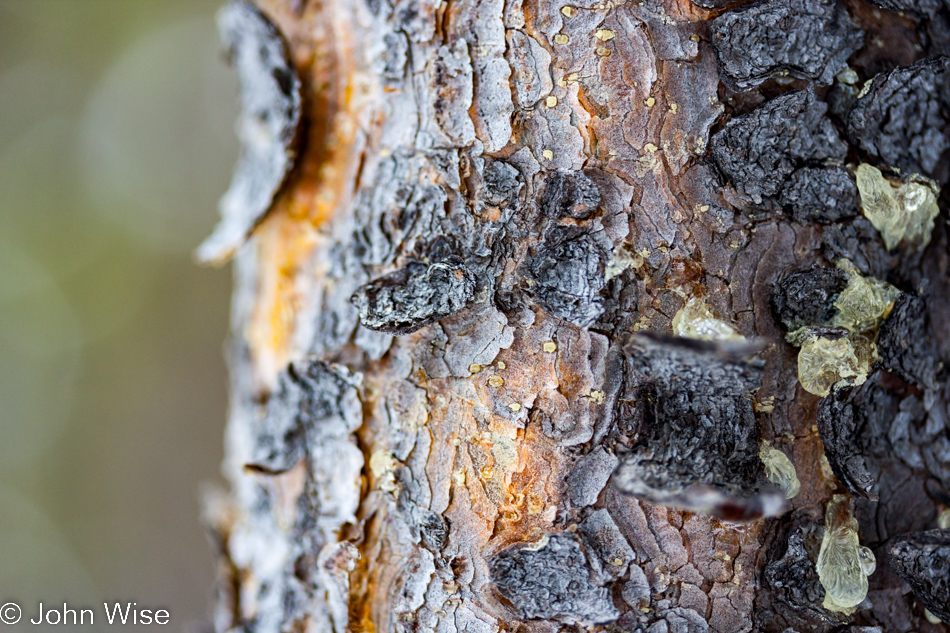
My mind is quiet, thoughts are distant. Today is a day to observe the world around me with an uncritical but still curious eye. Six days was what it took before I could fall into and become part of the scenery of Yellowstone. The previous days were spent collecting – collecting the sights, sounds, and smells of the park with a mind racing to have it all. Today, we are here alone, although the drone of the snowmobiles is three hours of background noise in the distance: on the trail, we are the only humans.
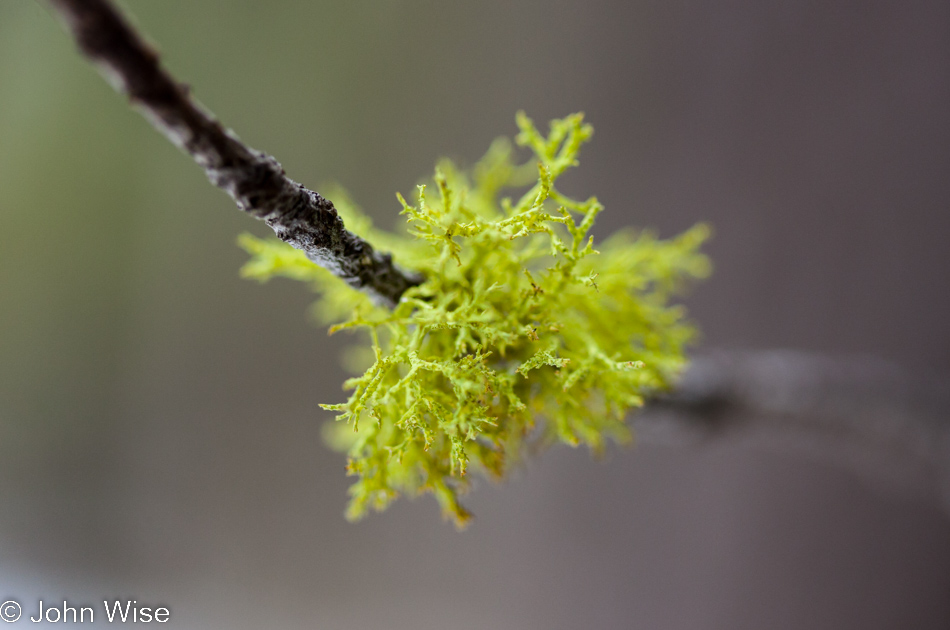
A rough trail going to Mallard Lake takes us to an infrequently visited hot spring and mud pots in the forest. We are in no hurry and take time to listen and watch. The squirrels are signaling to one another that we have arrived with a raucous chatter of squeals between treetops that we had at first thought were bird sounds. We have looked at the features of the major geyser basins a dozen times before and are making an effort today to see what we have not seen before. Tree bark, sap, moss, lichen, and hoar frost all demand a closer inspection.
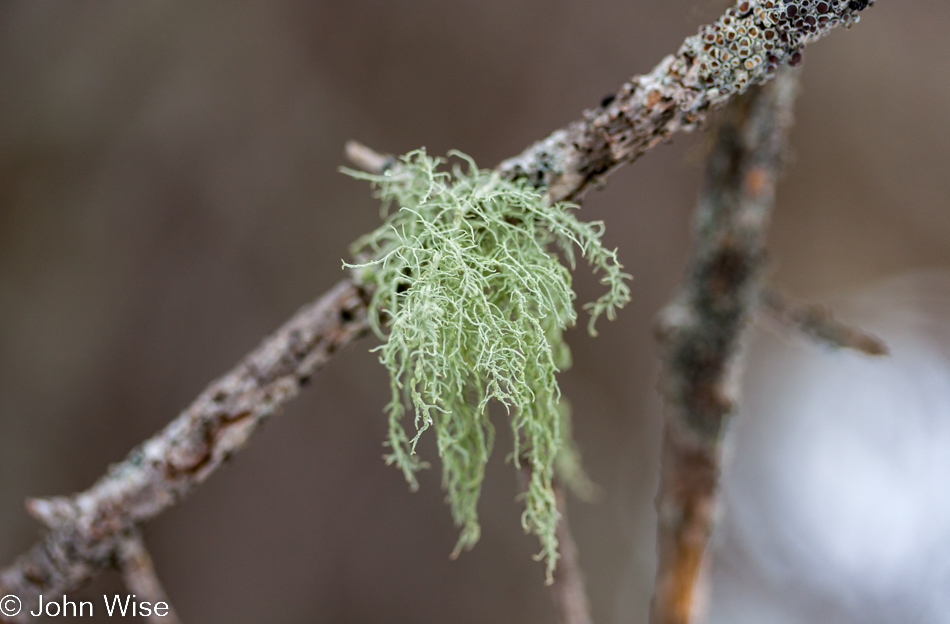
We are standing in the forest like a tree rooted in the soil; little is moving, it is still and quiet, besides the breeze that ruffles some branches overhead. The rustle of our synthetic layer of clothes brushing against our pant legs and arms adds a sound of plastic friction not belonging to this natural space. We try not to move or be seen so that nature might return to its routine that the intruders are disturbing. I want to experience this place and moment in which artifice has no place.
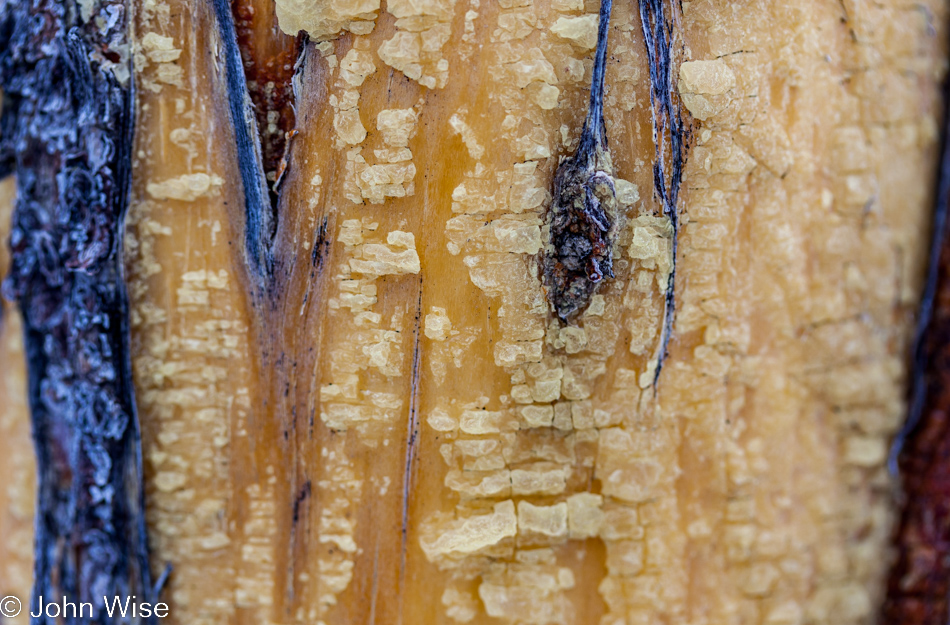
A nearby tree, now a well-worn scratch post for elk, stands with one side stripped of bark. During the summer, it appears to have become a favorite of male elk in need of shedding the velvet that covers their maturing antlers. In an effort to try to protect itself, the raw blond wood of the tree has sent out sap, which has crystallized into a second skin. We stop to stick a finger into nature, to poke the piney sap and delight in its sweet smell. With great affection, we inspect the granularity of exposed wood and believe we could stay here all day staring at the minutiae.
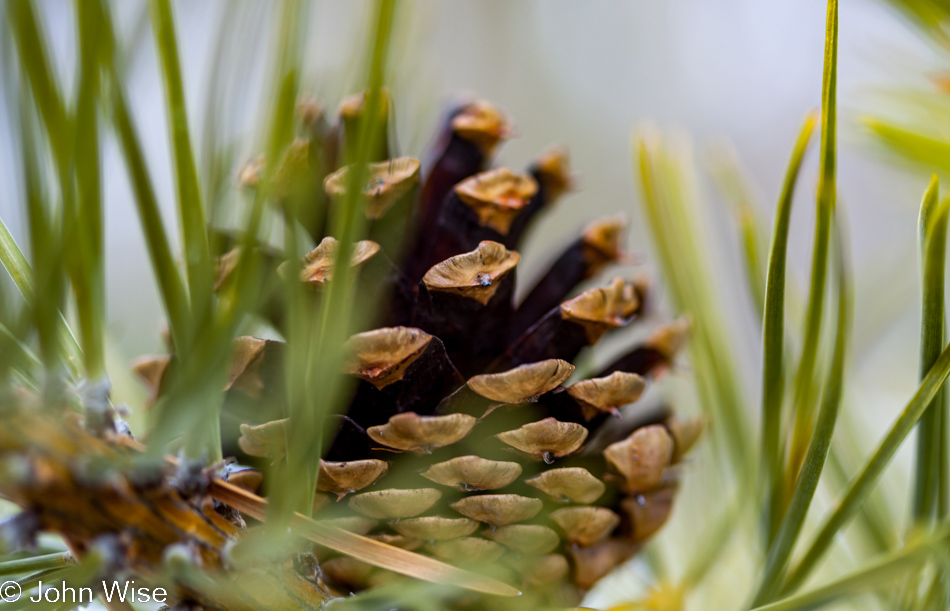
Inching along the trail going up the hill, we pass our turn. There seems to be a pull to see what’s just over the next rise, and as one would expect, it’s another hill. From time to time, a light snow flurry dances through the frigid air; we wonder if it’s a prelude to something greater. It isn’t and won’t be. The crunch of dry, frozen, and packed snow underfoot crunches in rhythm to our gait like a metronome, keeping the beat. It is a rhythmic sound not fitting the random natural soundscape playing in these woods. We must stop to allow the natural order to take back charge.
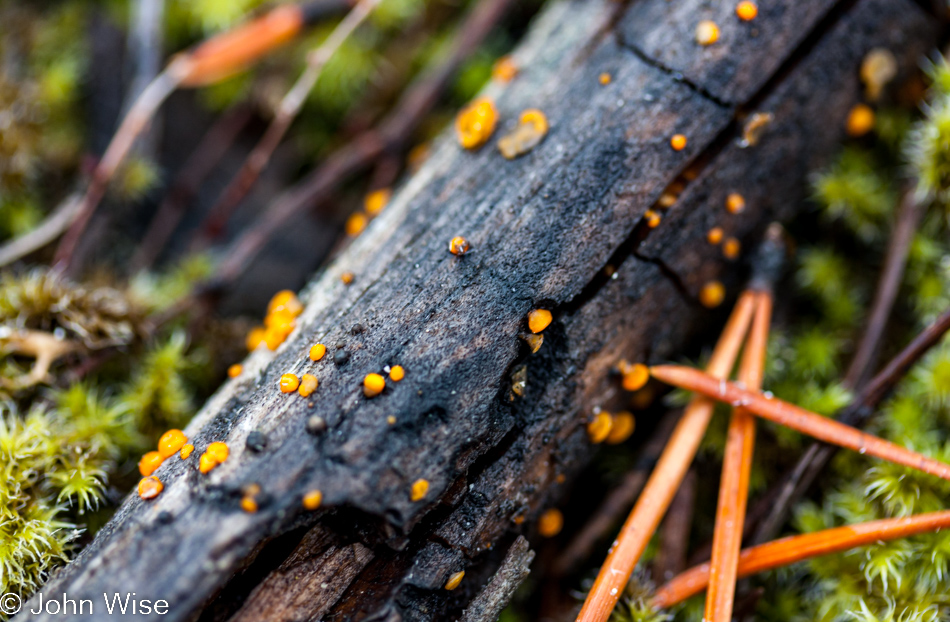
After backtracking to our ill-defined turn, the haphazard trail leads us over fallen limbs. We jump across a small stream as we try to avoid the deeper bison hoof holes that puncture the snow to the ground below. Massive plops of bison poo are skirted, then finally, we are delivered to our reward. An unnamed hot spring and mud pots in a small clearing. The is no boardwalk and no fence besides the self-imposed fence of common sense that demands we leave the area as we find it so others will have the same opportunity to see and define what this sight means to them.
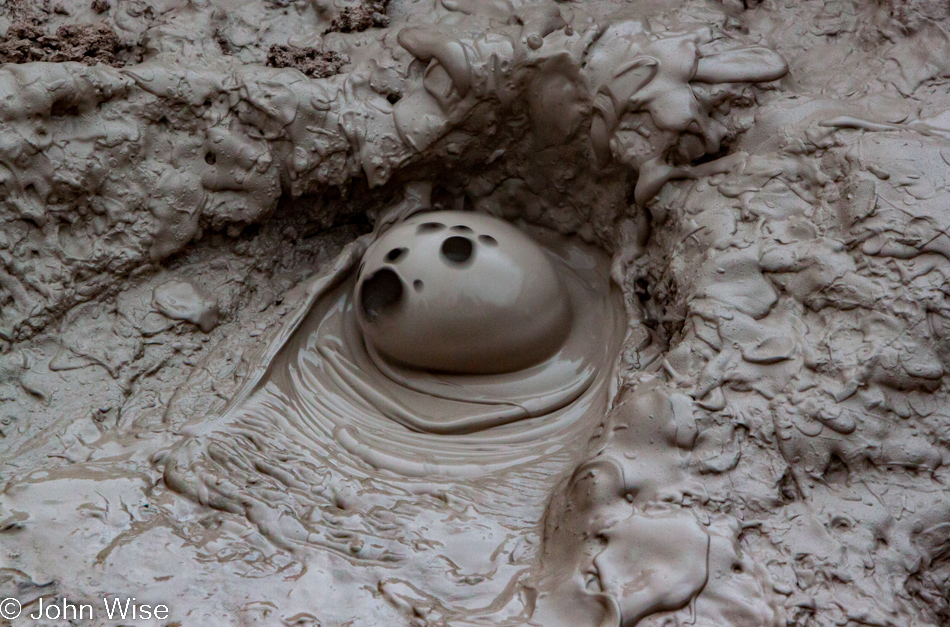
Gas is hissing as it escapes the earth’s grasp; maybe it is angry for being held so long. Caroline squats down to record the sound of heavy mud bubbling up with a thick sound of slowness. The rolling brown sludge pops and a new layer is stacked on an older one before they spread out to begin their sink back into the depths from where they emerged. Some mud is so thin as to be considered more water than mud – its boil has the more familiar sound we often hear on our stoves as the pot comes to a boil. The steaming hot spring behind the mud pot breaks its silence to let gas rise from its center, bringing to mind a giant cauldron of a mysterious emerald potion.
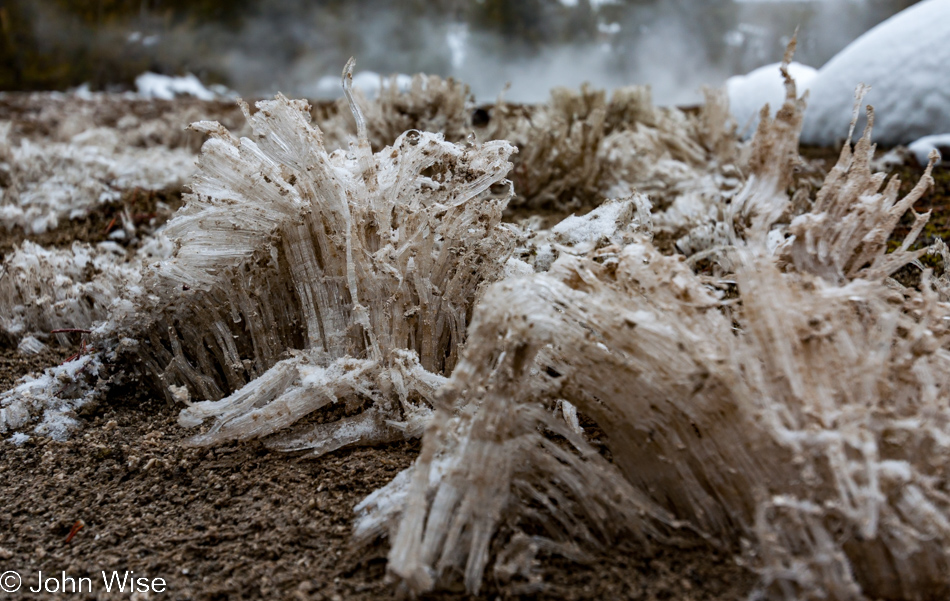
Hoar frost appears to crawl from the depths below, rising from the loose gravel. Tendril-like ice sticks latch onto invisible air supports as these shoestring clumps of fragile sculptures grow from the frozen surface, defying my imagination as to what this process must look like as the ice sprouts and aims upward. YouTube does not come to the rescue this time to show me a time-lapse of how this plays out.
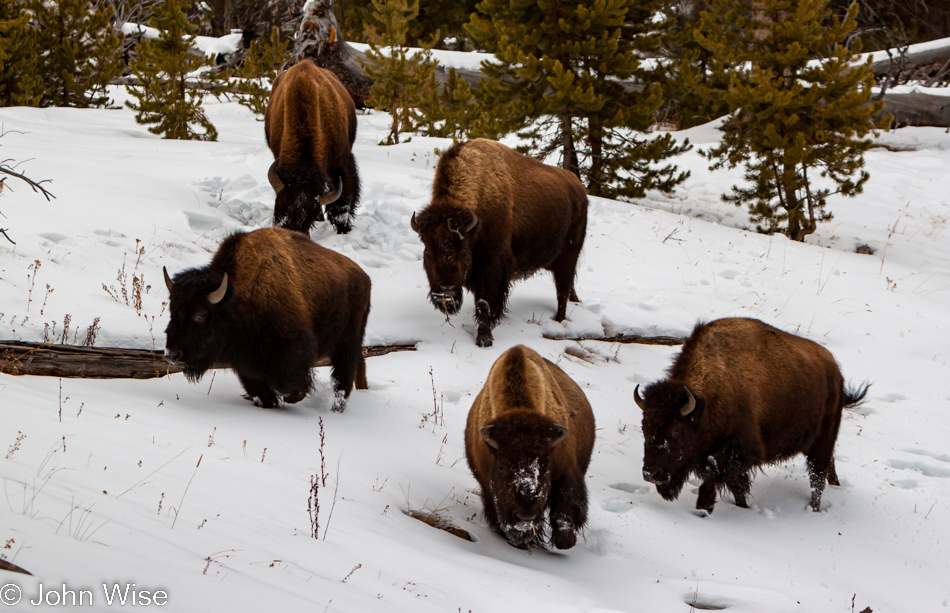
Back down the trail and over a small bridge crossing the Firehole River where earlier we had spotted a few bison in the distance – they are gone. These lumbering creatures haven’t moved far, though, and it is we hope, in our good fortune, that they are moving in the same direction we are. We cross over the Firehole on the bridge near Old Faithful and turn right on the Observation Trail, hoping the bison are coming this way. Either they are moving faster than we thought, or the herd is larger than we considered. The latter is true; we count twenty-six bison. For close to a half-hour, we stand next to a large boulder, trying to blend in, watching the bison gracefully sway their head back and forth, foraging for buried grasses under the snow. One heads up the hill, three meanders downhill, and two more eyeball us on the trail as if they are as nervous of our presence as we are of theirs. We oblige the bison and return to the Upper Geyser Basin boardwalk. As we try to keep a safe distance with three bison on our left, a couple is approaching from dead ahead, while a few who had been down the hill start climbing – we are being encircled. Hastily, we aim for our one escape on the very icy boardwalk, passing Beehive Geyser. By now, we have watched this herd for more than an hour, feeling like half a day has passed.
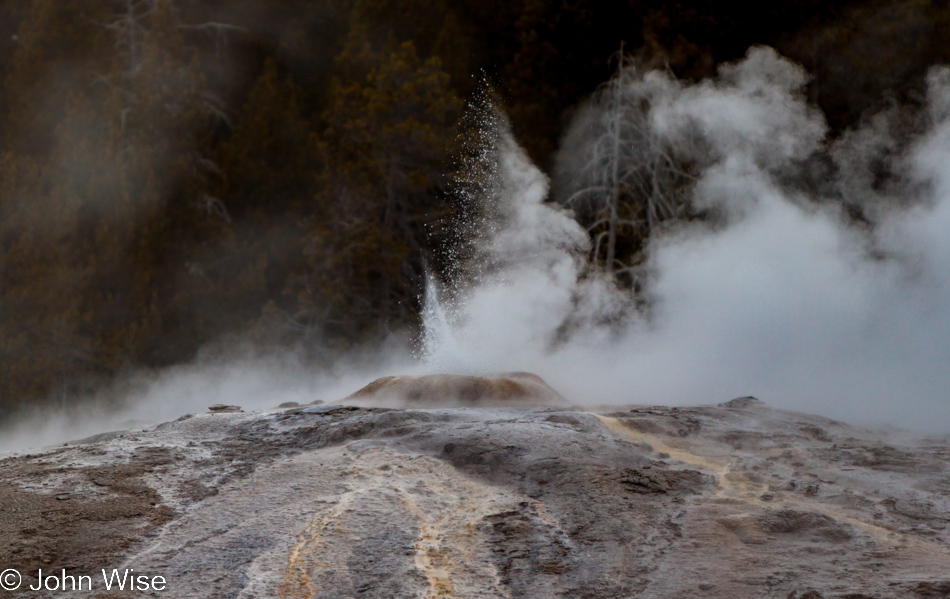
It’s gray and overcast, with a cold, light wind starting to bite. The bison are forcing us to head towards the western bridge over the Firehole near Castle Geyser. We walk along slowly, occasionally looking over our shoulders to ensure enough space remains between us and the bison who are blocking the south bridge. The Lion Group of thermal features are letting off a little steam and kicking up some low-grade eruptions that take our thoughts from the cold and the marauding herd behind us.
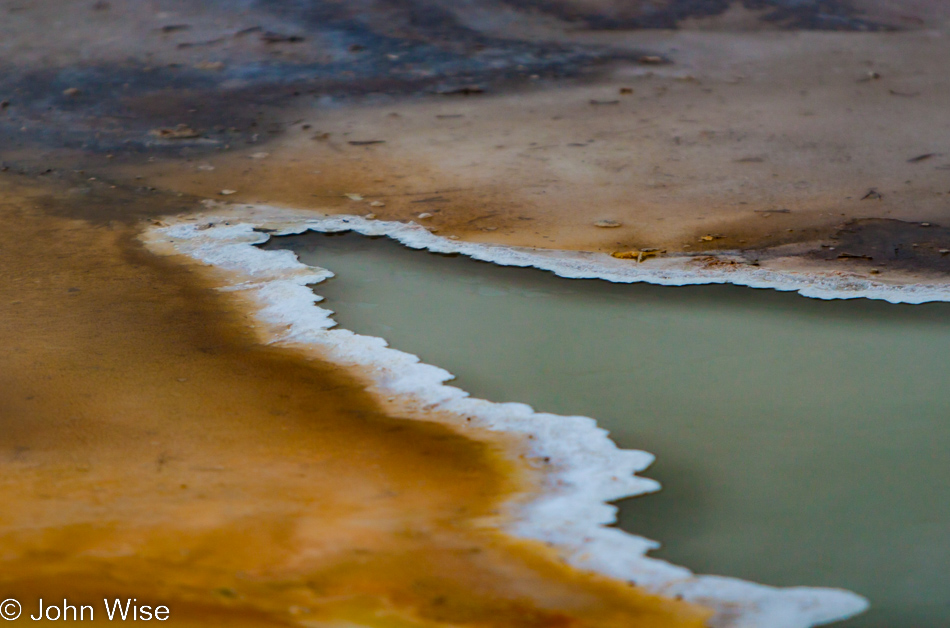
Once again, at Heart Spring, its beauty is not in short supply. A limestone lip looks to be floating on the water surface with its fractal edges rolling on forever in imperceptible crystalline structures that grow larger every day. Under the dull light of today, everything but the shape of Heart Spring looks different. The bacteria mat may not be as vibrant, but it looks altogether like something else, as though the pigments of the life forms are light-aware and change for the occasion.
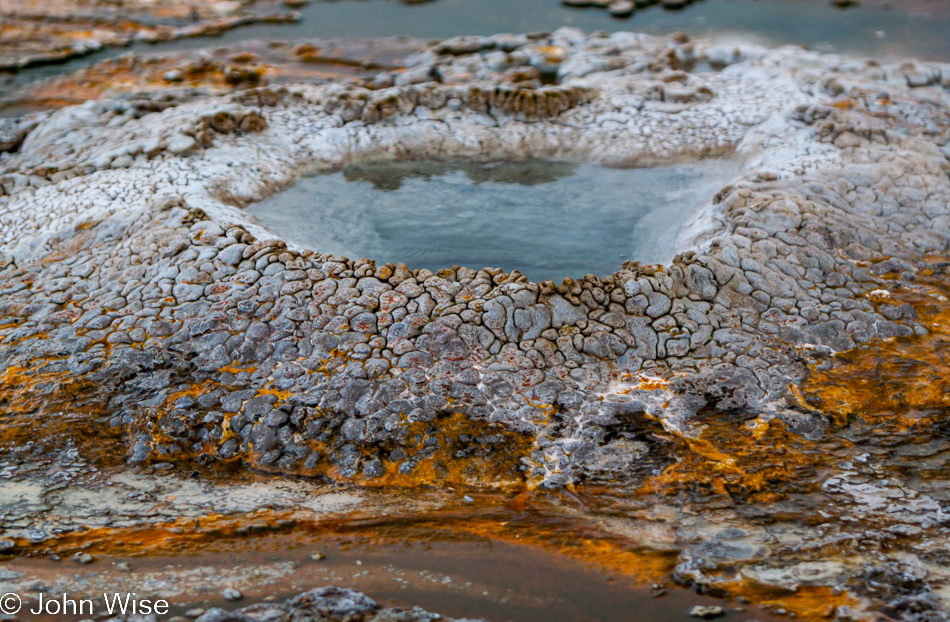
Be careful looking here, in places where, just the moment before, you thought you had seen all there was to be observed; upon looking again, you will spot that special treasure you could have sworn wasn’t there a second before. I know for a fact I walked past this unnamed rusty cone yesterday, not having noted precisely where this photo was taken. It could, in fact, be part of a named group but now, looking at the image, I cannot say from precisely where it came. When I was on the boardwalk, this caught my eye; it looked brand new to me. I had simply gone by previously without giving it a second thought – could I have been so callous? Am I guilty, too, of seeing the big picture and maybe, on more than one occasion have missed seeing the smaller detail?
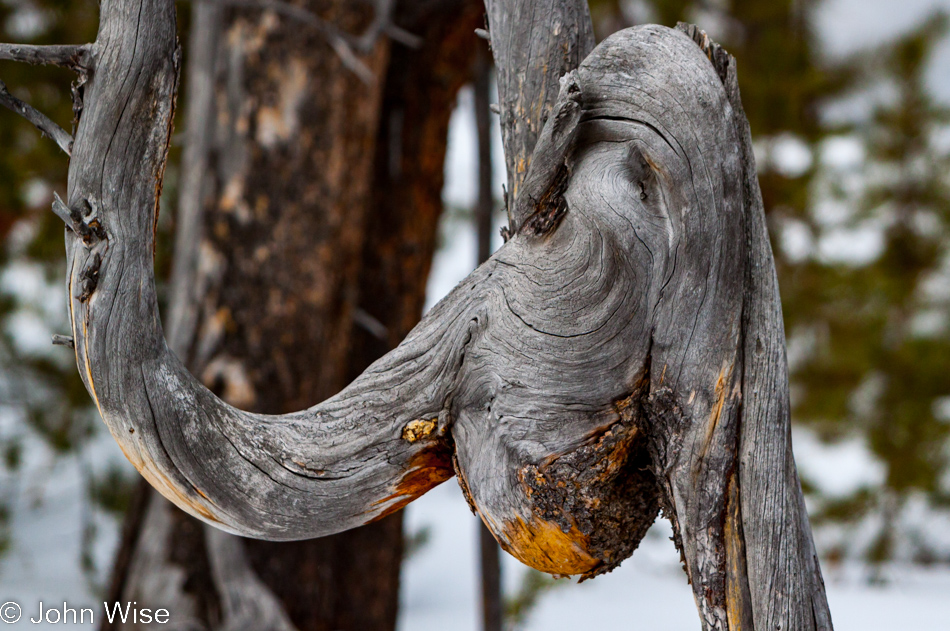
I strain to see more. I cannot say with any certainty if and when I will have the opportunity to walk the land of the world’s first national park again. I want to remember every detail, every corner, every bend. The forms and shapes, the contrasting colors, textures, and sounds are too much for my conscious mind; my only hope is that I might displace memories of useless television shows and overwrite them with truly valuable images. I plead with my subconscious mind to record every bit of information so that my future dreams will walk through billowy steam, gaze upon Kodachrome-colored landscapes, and inspect the granularity of the wood texture in that old tree.
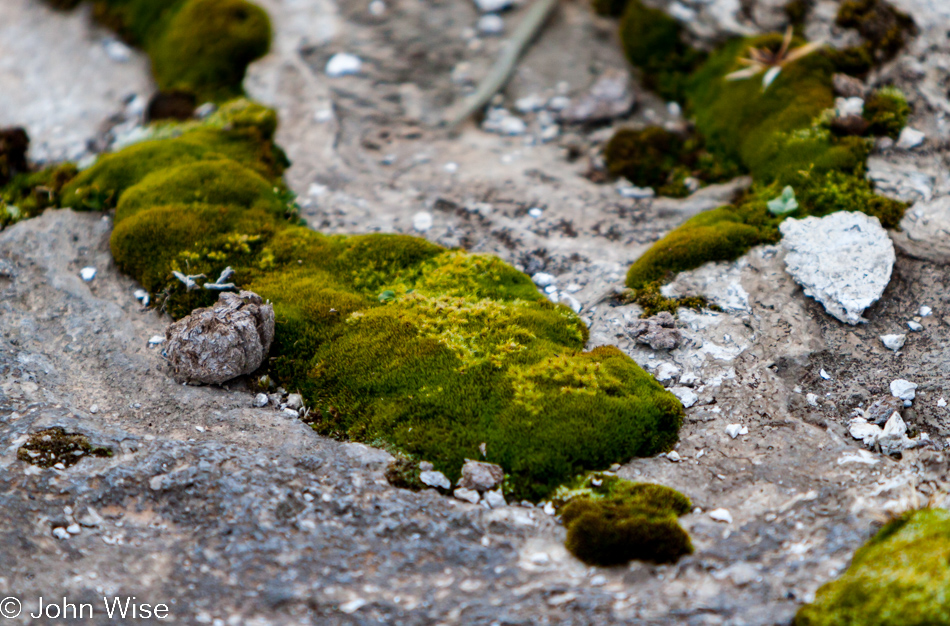
A favor to ask of the Park Service: oh, grant me the occasion to stroll unencumbered by the rules; let me crawl down upon the earth to find intimacy with the grains of sand. I need to tease out the details of individual leaves in the moss to witness firsthand these multicelled rhizoids. Yes, Wikipedia and technology do have a place for us (within reason) to better understand the natural world around us. My day today has been obsessed with fine detail; my future visits will hopefully take me into the atomic and molecular structure of this place until one day I may observe Yellowstone from space; maybe then I may feel that I have seen a little something of this park.
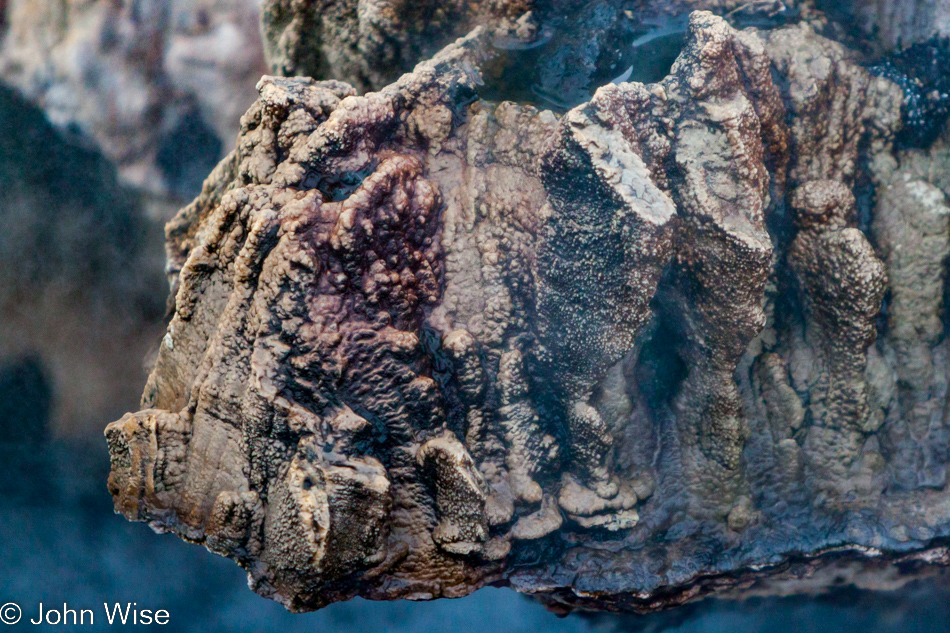
Just to the right of the moss is a boiling cauldron. Clearwater rises and thrashes about, and it could be that action of fury that grabs your attention, but just above the surface of the churn is this stone relic, reminding me of the fossilized head of some ancient and extinct creature that roamed this land so many millions of years ago. I can still see the leathery texture of its petrified skin, its lower jaw now missing. What you are really looking at are the deposits of minerals that have been shaped, formed, broken, and worn by the forces of nature. Not being a geologist, I cannot tell you if this is still growing or, if it’s eroding, or both. I can wonder whether the steam might carry enough minerals that could be bonding to this outcropping, and it is the wonder of my imagination that propels me to want to know more, to come back, to learn more than my simple mind allows me to appreciate from making observations.
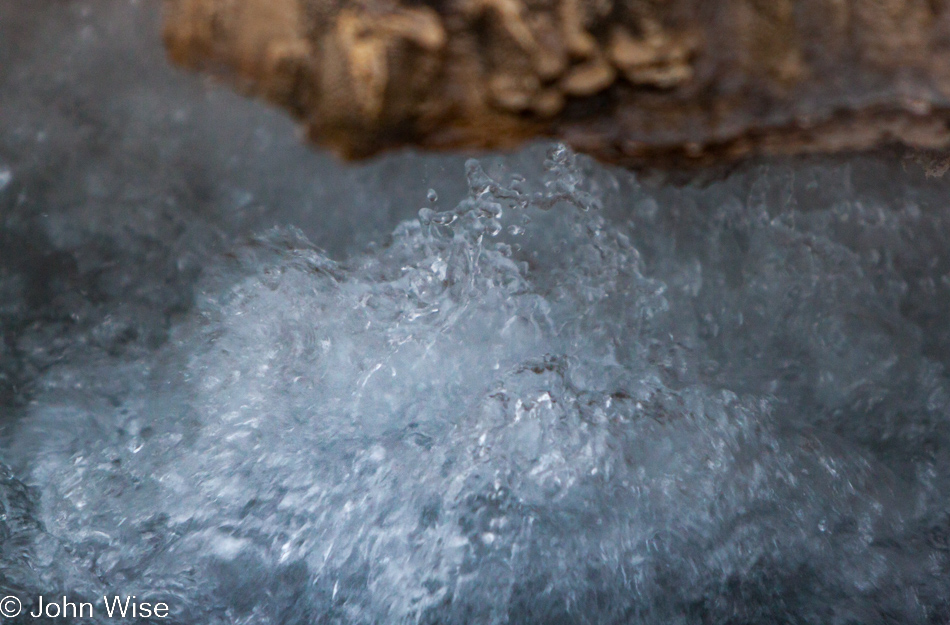
And below, the water. Rising up from the earth. Tracing a path through the plumbing from the depths until maybe a thousand years, maybe a million years later, it returns to the surface. Some of it, escaping as gas, will join clouds above and travel another thousand miles before it condenses and falls as rain on the heads of pedestrians out for a stroll on the streets of New York. As the water erupts, some will splash over the rim to collect in a pool before flowing off to join the Firehole River. When those waters join yet another river, will they, years from now, be found in a glass of lemonade about to be drunk on a hot summer day? Steam and overflowing water will feed the moss around the edges – will a passing animal nourish itself on a green lunch fed by these waters? Will some of this waterfall back into the earth, hidden deep below for another millennium, until someone else with an inquisitive mind looks into these depths and wonders if anyone else has ever seen just this water?
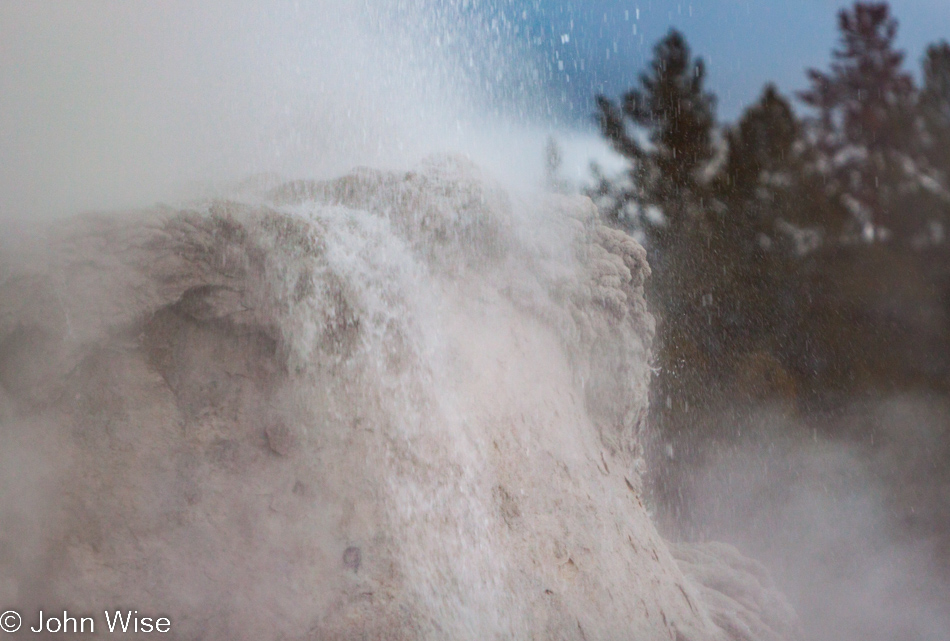
Sawmill Geyser is about to draw us in once again when Caroline notices Castle Geyser is erupting. The Castle is roaring, spitting, and fuming. Hysterical, expulsive fits of swirling steam, gas, and water are thrusting skyward. Out of the steam, sheets of rainfall quickly from the fast-rising clouds. The erupting water ceases, and the gas and steam take on new vitriol, cursing the earth below for holding it prisoner. The water, now jealous, rejoins the free-for-all in an attempt to steal the show by reaching for the heavens until both seemingly exhausted begin to fade, but it was a fool’s bet that things were over. Springing back to life, the entire process continues.
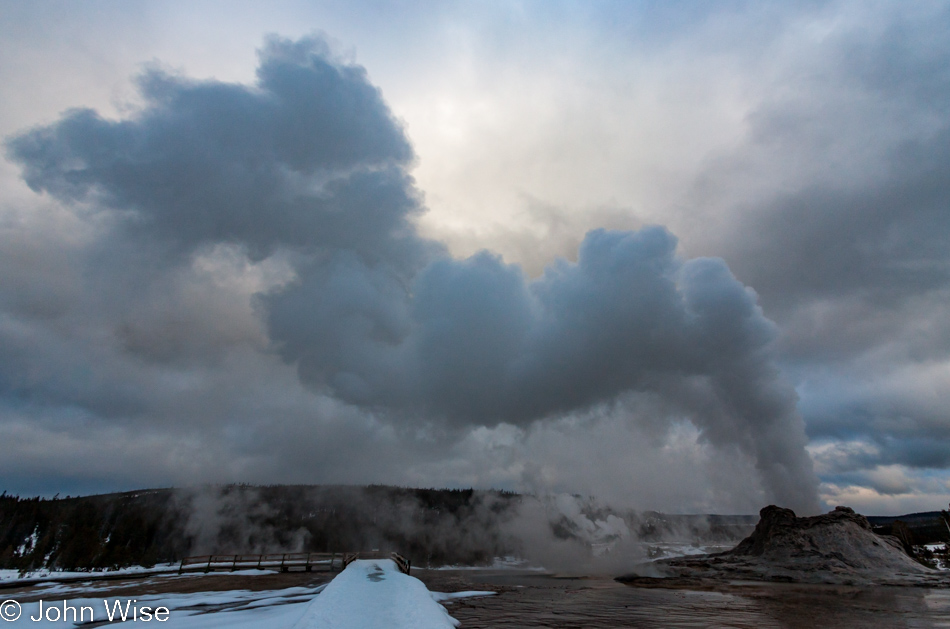
For over a half-hour we sit, stand, and walk around the display. We wonder how those who stopped by for a few minutes were able to pull themselves away as we wait in delight that we should be so lucky to be here to watch the entirety of an eruption cycle of Castle Geyser. As the glow of twilight is getting ready to give way to the approaching night, the Castle calms its rebellion and returns to silence and us to the Snow Lodge.